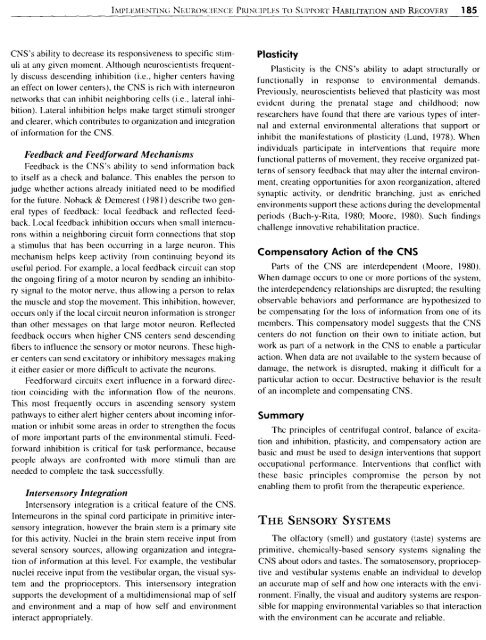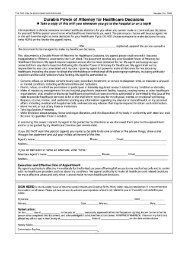Implementing Neuroscience Principles to Support Habilitation and ...
Implementing Neuroscience Principles to Support Habilitation and ...
Implementing Neuroscience Principles to Support Habilitation and ...
Create successful ePaper yourself
Turn your PDF publications into a flip-book with our unique Google optimized e-Paper software.
CNS's ability <strong>to</strong> decrease its responsiveness <strong>to</strong> specific stimuli<br />
at any given moment. Although neuroscientists frequently<br />
discuss descending inhibition (i.e., higher centers having<br />
an effect on lower centers), the CNS is rich with interneuron<br />
networks that can inhibit neighboring cells (i.e., lateral inhibition).<br />
Lateral inhibition helps make target stimuli stronger<br />
<strong>and</strong> clearer, which contributes <strong>to</strong> organization <strong>and</strong> integration<br />
of information for the CNS.<br />
Feedback <strong>and</strong> Feedforward Mechanisms<br />
Feedback is the CNS's ability <strong>to</strong> send information back<br />
<strong>to</strong> itself as a check <strong>and</strong> balance. This enables the person <strong>to</strong><br />
judge whether actions already initiated need <strong>to</strong> be modified<br />
for the future. Nohack & Dernerest ( 198 I ) describe two general<br />
types of feedback: local feedback <strong>and</strong> reflected feedback.<br />
Local feedback inhibition occurs when small interncurons<br />
within a neighboring circuit form connections that s<strong>to</strong>p<br />
a stimulus that has been occurring in a large neuron. This<br />
mechanism helps keep activity froin continuing beyond its<br />
iiseful period. For example, a local feedback circuit can s<strong>to</strong>p<br />
the ongoing firing of a nio<strong>to</strong>r neuron by sending an inhibi<strong>to</strong>ry<br />
signal <strong>to</strong> the mo<strong>to</strong>r nerve, thus allowing a pcrson <strong>to</strong> relax<br />
the muscle <strong>and</strong> s<strong>to</strong>p the movement. This inhibition, however,<br />
occurs only if the local circuit neuron information is stronger<br />
than other messages on that large mo<strong>to</strong>r neuron. Reflected<br />
feedback occurs when higher CNS centers send descending<br />
fibers <strong>to</strong> influence the sensory or nio<strong>to</strong>r neurons. These higher<br />
centers can send excita<strong>to</strong>ry or inhibi<strong>to</strong>ry messages making<br />
it either easier or more difiicult <strong>to</strong> activate the neurons.<br />
Feedforward circuits exert influence in a forward direction<br />
coinciding with the information flow of the neurons.<br />
This most frequently occurs in ascending sensory system<br />
pathways <strong>to</strong> either alert higher centers about incoming information<br />
or inhibit some areas in order <strong>to</strong> strengthen the focus<br />
of more important parts of the environmental stimuli. Feedforward<br />
inhibition is critical for task performance, because<br />
people always are confronted with more stimuli than are<br />
needed <strong>to</strong> complete the task successfully.<br />
Intersensory Integration<br />
Intersensory integration is a critical feature of the CNS.<br />
Interneurons in the spinal cord participate in primitive intersensory<br />
integration, however the brain stem is a primary site<br />
for this activity. Nuclei in the brain stem receive input from<br />
several sensory sources, allowing organization <strong>and</strong> integration<br />
of information at this level. For example, the vestibular<br />
nuclei receive input from the vestibular organ, the visual system<br />
<strong>and</strong> the propriocep<strong>to</strong>rs. This intersensory integration<br />
supports the development of a multidimensional map of self<br />
<strong>and</strong> environment <strong>and</strong> a map of how self <strong>and</strong> environment<br />
interact appropriately.<br />
Plasticity<br />
Plasticity is the CNS's ability <strong>to</strong> adapt structurally or<br />
functionally in response <strong>to</strong> environmental dem<strong>and</strong>s.<br />
Previously, neuroscientists believed that plasticity was most<br />
evident during the prenatal stage <strong>and</strong> childhood; now<br />
researchers have found that there are various types of internal<br />
<strong>and</strong> external environmental alterations that support or<br />
inhibit the manifestations of plasticity (Lund, 1978). When<br />
individuals participate in interventions that require more<br />
functional patterns of movement, they receive organized patterns<br />
of sensory feedback that may alter the internal environment,<br />
creating opportunities for axon reorganization, altered<br />
synaptic activity, or dendritic branching, just as enriched<br />
environments support these actions during the developmental<br />
periods (Bach-y-Rita, 1980; Moore, 1980). Such findings<br />
challenge innovative rehabilitation practice.<br />
Compensa<strong>to</strong>ry Action of the CNS<br />
Parts of the CNS are interdependent (Moore, 1980).<br />
When damage occurs <strong>to</strong> one or more portions of the system,<br />
the interdependency relationships are disrupted; the resulting<br />
observable behaviors <strong>and</strong> performance are hypothesized <strong>to</strong><br />
be compensating for the loss of information from one of its<br />
members. This compensa<strong>to</strong>ry model suggests that the CNS<br />
centers do not function on their own <strong>to</strong> initiate action, but<br />
work as part of a network in the CNS <strong>to</strong> enable a particular<br />
action. When data are not available <strong>to</strong> the system because of<br />
damage, the network is disrupted, making it difficult for a<br />
particular action <strong>to</strong> occur. Destructive behavior is the result<br />
of an incomplete <strong>and</strong> compensating CNS.<br />
Summary<br />
The principles of centrifugal control, balance of excitation<br />
<strong>and</strong> inhibition, plasticity, <strong>and</strong> compensa<strong>to</strong>ry action are<br />
basic <strong>and</strong> must be used <strong>to</strong> design interventions that support<br />
occupational performance. Interventions that conflict with<br />
these basic principles compromise the person by not<br />
enabling them <strong>to</strong> profit from the therapeutic experience.<br />
The olfac<strong>to</strong>ry (smell) <strong>and</strong> gusta<strong>to</strong>ry (taste) systems are<br />
primitive, chemically-based sensory systems signaling the<br />
CNS about odors <strong>and</strong> tastes. The soma<strong>to</strong>sensory, proprioceptive<br />
<strong>and</strong> vestibular systems enable an individual <strong>to</strong> develop<br />
an accurate map of self <strong>and</strong> how one interacts with the environment.<br />
Finally, the visual <strong>and</strong> audi<strong>to</strong>ry systems are responsible<br />
for mapping environmental variables so that interaction<br />
with the environment can he accurate <strong>and</strong> reliable.





